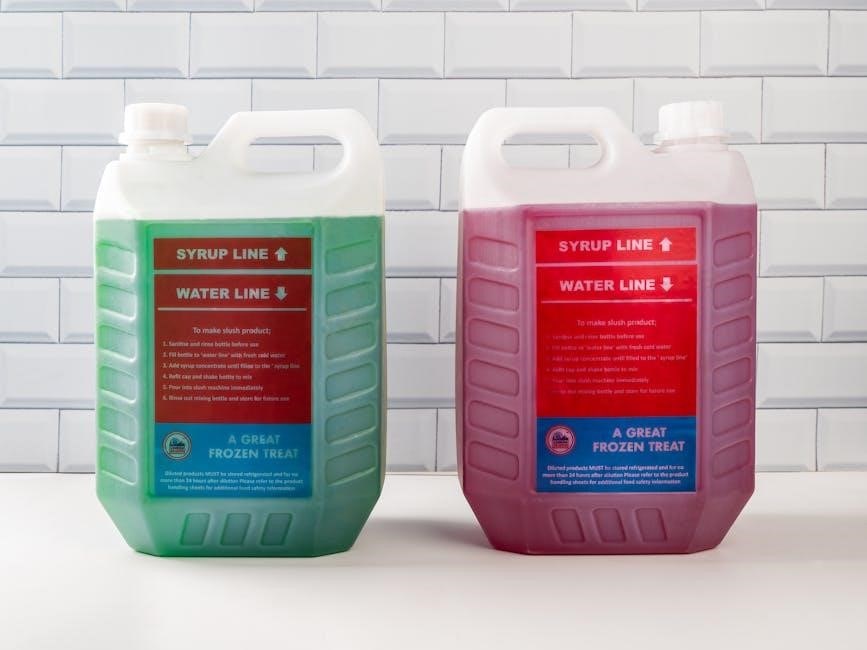Torocity Herbicide, containing mesotrione, is a versatile solution for pre-emergent and post-emergent weed control. Proper mixing ensures effective application and safety. This guide provides essential steps for optimal use.
Overview of Torocity Herbicide
Torocity Herbicide, containing the active ingredient mesotrione, is a versatile solution for controlling weeds in turfgrass. It effectively targets over 45 broadleaf and grassy weeds, offering both pre-emergent and post-emergent control. As a systemic herbicide, it inhibits photosynthesis in weeds, ensuring rapid and thorough results. Torocity is particularly effective when applied to clean sites and during early weed development. It is also an excellent tank mix partner with other herbicides, enhancing its versatility in weed management strategies. Proper mixing and application are crucial to maximize efficacy and safety, making it a reliable choice for maintaining healthy turfgrass. Its broad-spectrum control makes it a popular option for lawn care professionals and homeowners alike.
Importance of Proper Mixing Procedures
Proper mixing of Torocity Herbicide is crucial for ensuring effective weed control and minimizing potential risks to the environment and human health. Incorrect mixing can lead to uneven application, reduced efficacy, or even plant damage. Following the recommended mixing rate and water volume ensures the herbicide is applied at the correct concentration, optimizing its performance. Proper mixing also prevents clogging of spray equipment and ensures uniform coverage across the target area. Adhering to the manufacturer’s guidelines helps maintain the product’s integrity and safety profile. Improper mixing can result in underperformance or unintended consequences, making it essential to follow the instructions carefully for the best results and to avoid environmental contamination.

Types of Applications for Torocity
Torocity Herbicide is versatile, suitable for both pre-emergent and post-emergent applications. It effectively controls broadleaf weeds and grasses in turf, offering flexibility for different weed management strategies.
Pre-Emergent Application
Torocity Herbicide is highly effective when applied pre-emergently to prevent weeds from germinating. For this method, apply at a rate of 5-8 ounces per acre, or approximately 0.113-0.18 ounces per 1,000 square feet. This ensures systemic protection against broadleaf weeds and grasses. Timing is critical; apply before weed seeds germinate, typically in early spring or fall. Mix with water according to label instructions and apply uniformly to the treatment area. Avoid overseeding for at least 14 days after application to allow the herbicide to establish a protective barrier. Pre-emergent application provides long-lasting control, reducing the need for post-emergent treatments later in the growing season. Always follow safety guidelines and wait until the spray has dried before re-entering treated areas.
Post-Emergent Application
Torocity Herbicide is also highly effective for post-emergent weed control, targeting broadleaf weeds and grasses up to 45 species. Apply at a rate of 8-16 ounces per acre, ensuring thorough coverage of foliage. For best results, treat weeds when they are young and actively growing. The herbicide works systemically, meaning it is absorbed by the leaves and translocated to the roots for complete control. Post-emergent application is ideal for addressing weeds that have already germinated, providing quick and effective solutions. Always mix with water according to label instructions and apply uniformly. Avoid applications during extreme weather conditions, such as high heat or drought stress, to maximize efficacy and minimize plant stress. Proper timing ensures optimal results while maintaining turf health.
Step-by-Step Mixing Instructions
Fill the spray tank with water, add the recommended rate of Torocity Herbicide, and agitate thoroughly. Ensure uniform application for optimal weed control effectiveness.
Recommended Mixing Rate
The recommended mixing rate for Torocity Herbicide varies based on application type and target weeds. For pre-emergent control, apply at 5-8 oz per acre, while post-emergent applications typically require 4-8 oz per acre. Always mix with water at a volume of 20-40 gallons per acre for optimal coverage. Use a surfactant at 0.25-0.5% v/v to enhance herbicide efficacy. Ensure thorough agitation of the spray tank to maintain uniform distribution of the active ingredient. Proper calibration of equipment is essential to avoid under or over-application, which can impact results. Follow label instructions precisely and adjust rates based on weed pressure and environmental conditions for best outcomes. Always consult the product label for specific recommendations tailored to your application scenario.
Water Volume Requirements
The water volume for Torocity Herbicide applications should range between 20-40 gallons per acre, depending on the type of sprayer and nozzle used. Higher water volumes are recommended for broadcast applications to ensure thorough coverage, while lower volumes are suitable for spot treatments. The ideal water volume should provide uniform droplet distribution without excessive runoff. Always use clean, cold water for mixing, as contaminants or extreme temperatures can affect herbicide performance. For optimal results, maintain a consistent water volume throughout the application to ensure the correct amount of active ingredient is delivered. Proper calibration of spray equipment is essential to achieve the desired water volume and avoid under or over-application.
Tank Mixing with Other Herbicides
Torocity Herbicide can be tank-mixed with other herbicides to enhance weed control and broaden the spectrum of activity. When tank-mixing, always follow the label instructions of both products to ensure compatibility and avoid antagonism. Common tank-mix partners include grass herbicides and other broadleaf weed control agents. It is crucial to conduct a jar test before mixing to check for any potential incompatibilities, such as settling or precipitation. Start by adding half the required water to the spray tank, then add Torocity followed by the tank-mix partner. Complete the tank with water, ensuring thorough agitation to maintain a uniform mixture. Always refer to the product labels for specific recommendations and precautions.

Safety Precautions and Protective Equipment
Wear protective equipment, including gloves, long sleeves, and eyewear, when handling Torocity. Avoid skin contact and ensure treated areas are dry before re-entry. Keep first aid measures nearby.
Personal Protective Equipment (PPE)
When handling Torocity Herbicide, it is crucial to wear appropriate Personal Protective Equipment (PPE) to minimize exposure risks. This includes long-sleeved shirts, long pants, closed-toe shoes, and chemical-resistant gloves. Additionally, wear protective eyewear, such as goggles or safety glasses, to prevent eye irritation. A face mask or respirator is recommended to avoid inhaling spray droplets. Ensure all clothing is clean and free from pesticides or other contaminants. Avoid wearing leather goods, as they are difficult to decontaminate. If PPE is not worn correctly, skin irritation or other health issues may occur. Always follow the product label’s PPE recommendations to ensure safe handling and application of Torocity Herbicide.
First Aid Measures
In case of exposure to Torocity Herbicide, immediate action is essential to minimize potential health risks. If the product comes into contact with the skin, remove contaminated clothing and rinse the affected area with plenty of water for 15–20 minutes. For eye exposure, flush with clean water for 15–20 minutes, seeking medical attention if irritation persists. If ingested, do not induce vomiting; instead, drink water and seek immediate medical care. Inhale spray mist, move to fresh air and consult a doctor if breathing difficulties arise. These measures ensure timely intervention and prevent severe health complications; Always refer to the product label for detailed first aid instructions and consult a healthcare professional if needed.

Storage and Disposal Guidelines
- Store Torocity Herbicide in its original container, away from heat sources and direct sunlight. Ensure the area is well-ventilated and inaccessible to children and pets.
- Dispose of unused product and containers according to local regulations. Do not discharge into drains or waterways to prevent environmental contamination.
Proper Storage Conditions
Torocity Herbicide should be stored in its original container, tightly sealed, and kept in a cool, dry, well-ventilated area. The ideal storage temperature is between 40°F and 90°F (4°C and 32°C). Avoid exposure to direct sunlight, heat sources, or open flames; Ensure the storage area is inaccessible to children, pets, and livestock. Do not store near fertilizers or other chemicals to prevent cross-contamination. Check the container regularly for signs of damage or leakage. Always follow the label instructions for storage to maintain product efficacy and safety. Proper storage ensures the herbicide remains effective for its intended use and minimizes environmental risks. Store only in areas approved for pesticide storage.
Environmental Disposal Practices
Dispose of Torocity Herbicide and its container responsibly to protect the environment. Follow all local, state, and federal regulations for pesticide disposal. Do not reuse the container for any other purpose. Take leftover herbicide and rinsed containers to an EPA-approved hazardous waste facility. Clean equipment thoroughly after use and dispose of washwater according to regulations. In case of spills, contain and neutralize the area to prevent contamination. Never discharge Torocity or rinse water into sewers, drains, or waterways. Check with local authorities for specific disposal guidelines in your region. Proper disposal ensures environmental safety and compliance with legal standards. Always prioritize eco-friendly practices when handling herbicides.

Troubleshooting Common Issues
Identify and address application errors promptly. Check for inconsistent mixing rates or improper timing. Ensure equipment is calibrated and free from contamination. Adjust as needed for optimal results.
Addressing Ineffective Application
Ineffective application of Torocity Herbicide can occur due to improper mixing rates or timing. Ensure the recommended rate of 5-8 oz per acre is used, adjusting for target weeds and turf type. Verify water volume aligns with label guidelines, as insufficient or excessive water can reduce efficacy. Avoid applying during extreme weather conditions, such as high winds or imminent rainfall, which may disrupt coverage. Check for contamination or equipment calibration issues, as these can lead to uneven distribution. Re-application may be necessary in cases of poor coverage or persistent weeds. Always follow label instructions and consider tank-mix compatibility to optimize results and prevent resistance development. Proper timing and adherence to guidelines are critical for effective weed control.
Optimizing Application Timing
Optimizing the timing of Torocity Herbicide application is crucial for achieving effective weed control. For pre-emergent applications, apply Torocity before weed germination, typically in early spring or late summer, depending on the target species. Post-emergent applications should target weeds at their early growth stages, ensuring optimal absorption and systemic action. Avoid applying during extreme weather conditions, such as high winds, rainfall, or freezing temperatures, as this can reduce efficacy. Soil moisture levels should be adequate to facilitate herbicide activity but not saturated, as this may lead to runoff. Proper timing enhances the herbicide’s performance, ensuring long-lasting control and minimizing the risk of weed resistance. Always consult the label for specific timing recommendations based on your turf type and target weeds.




